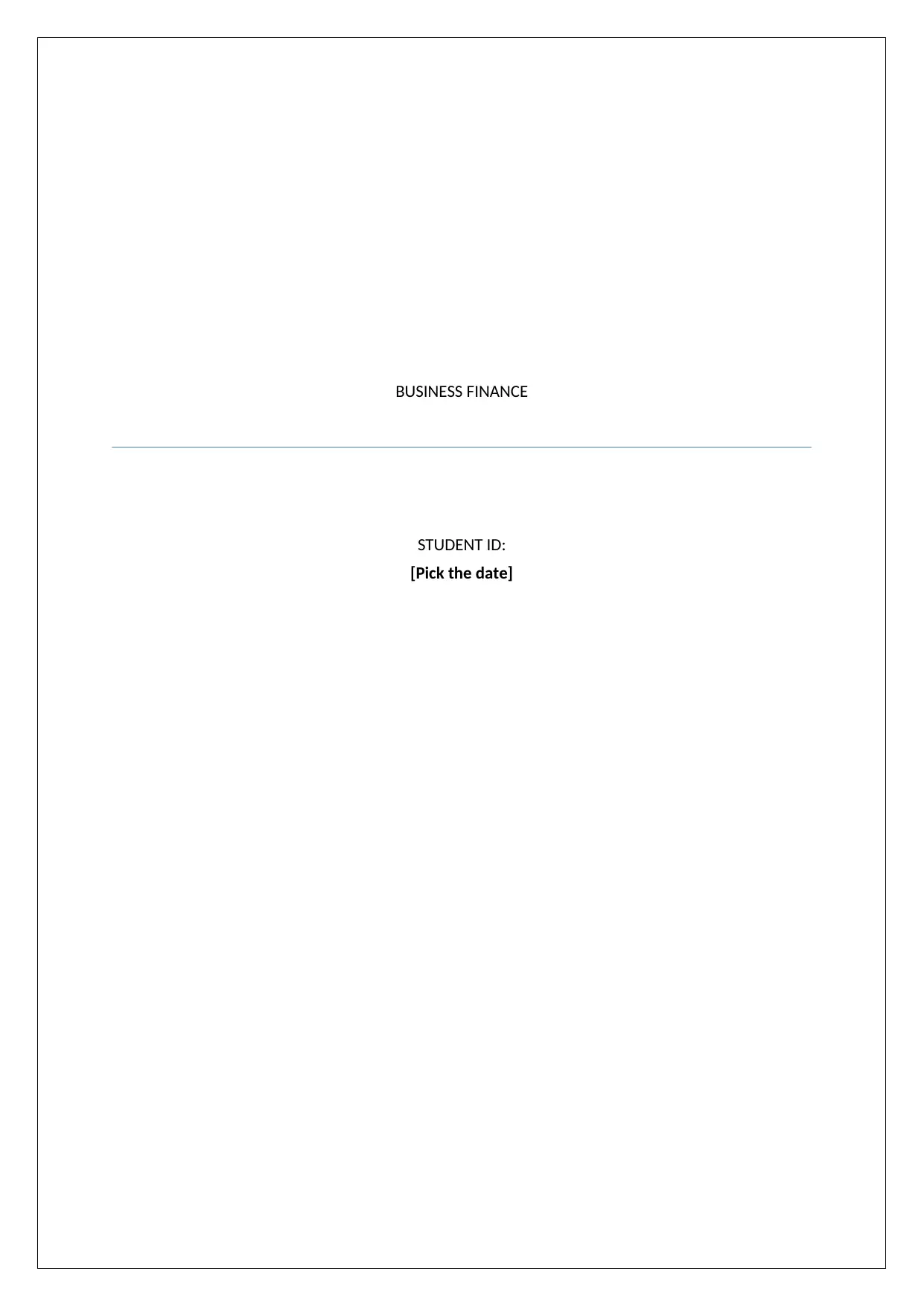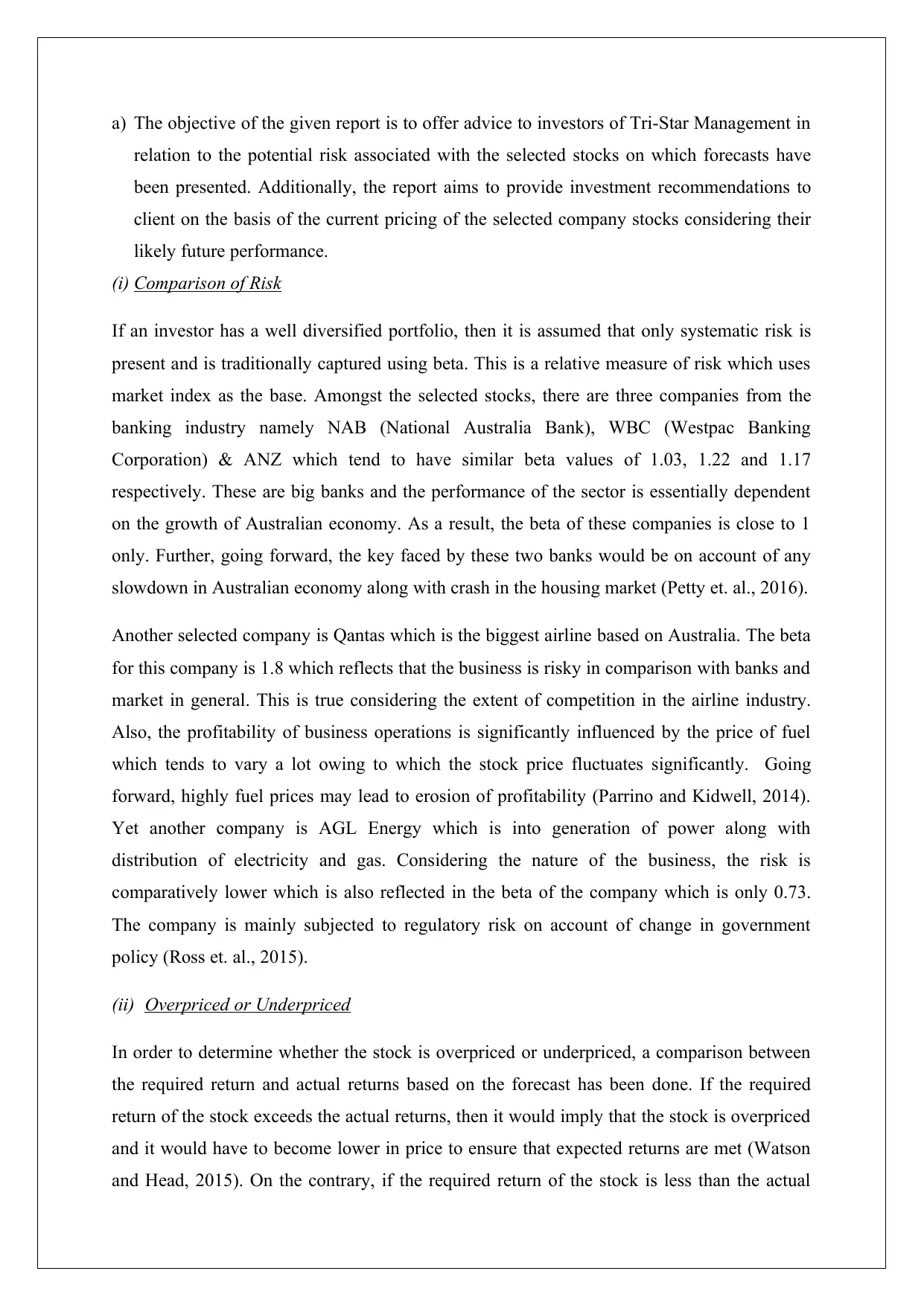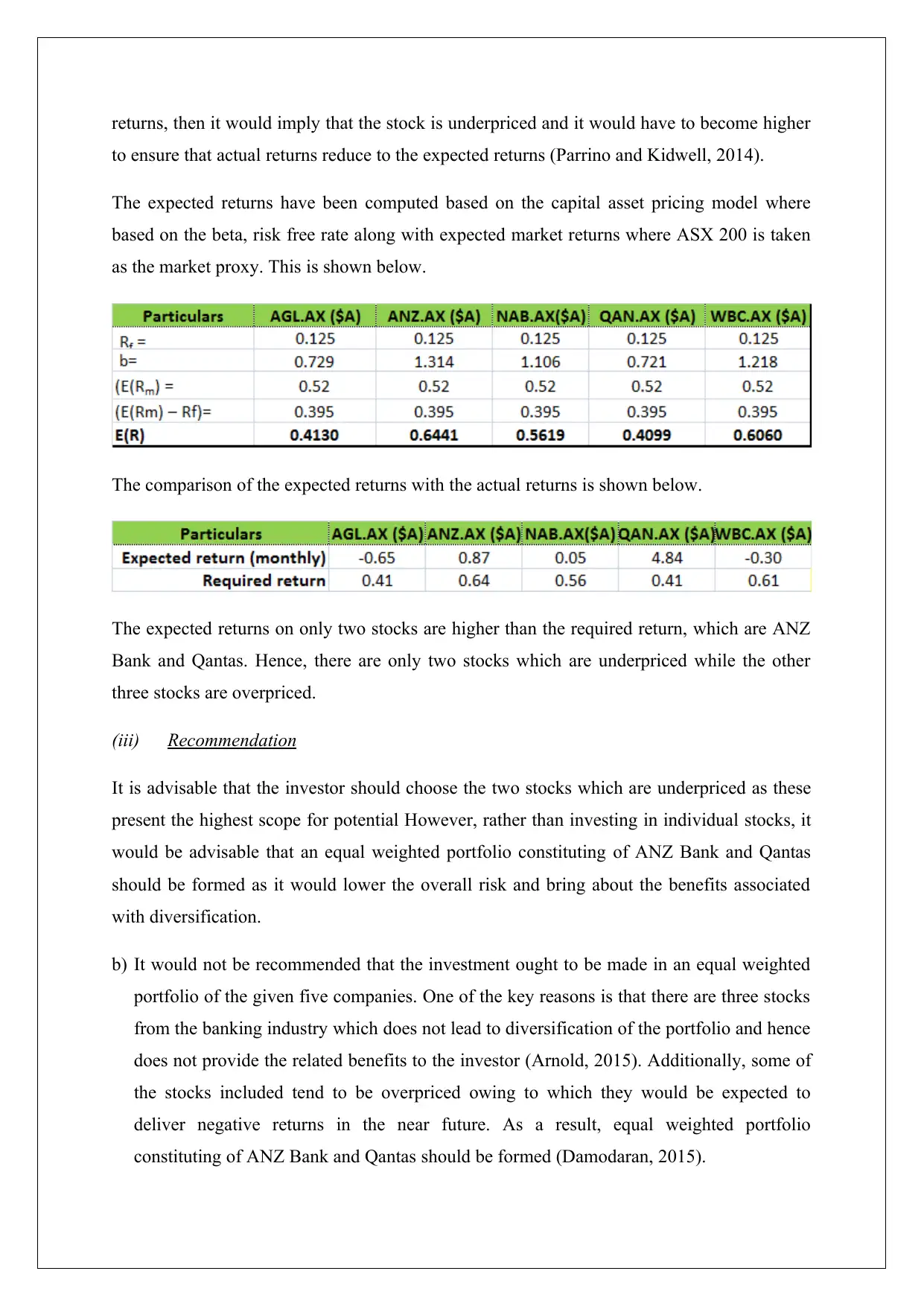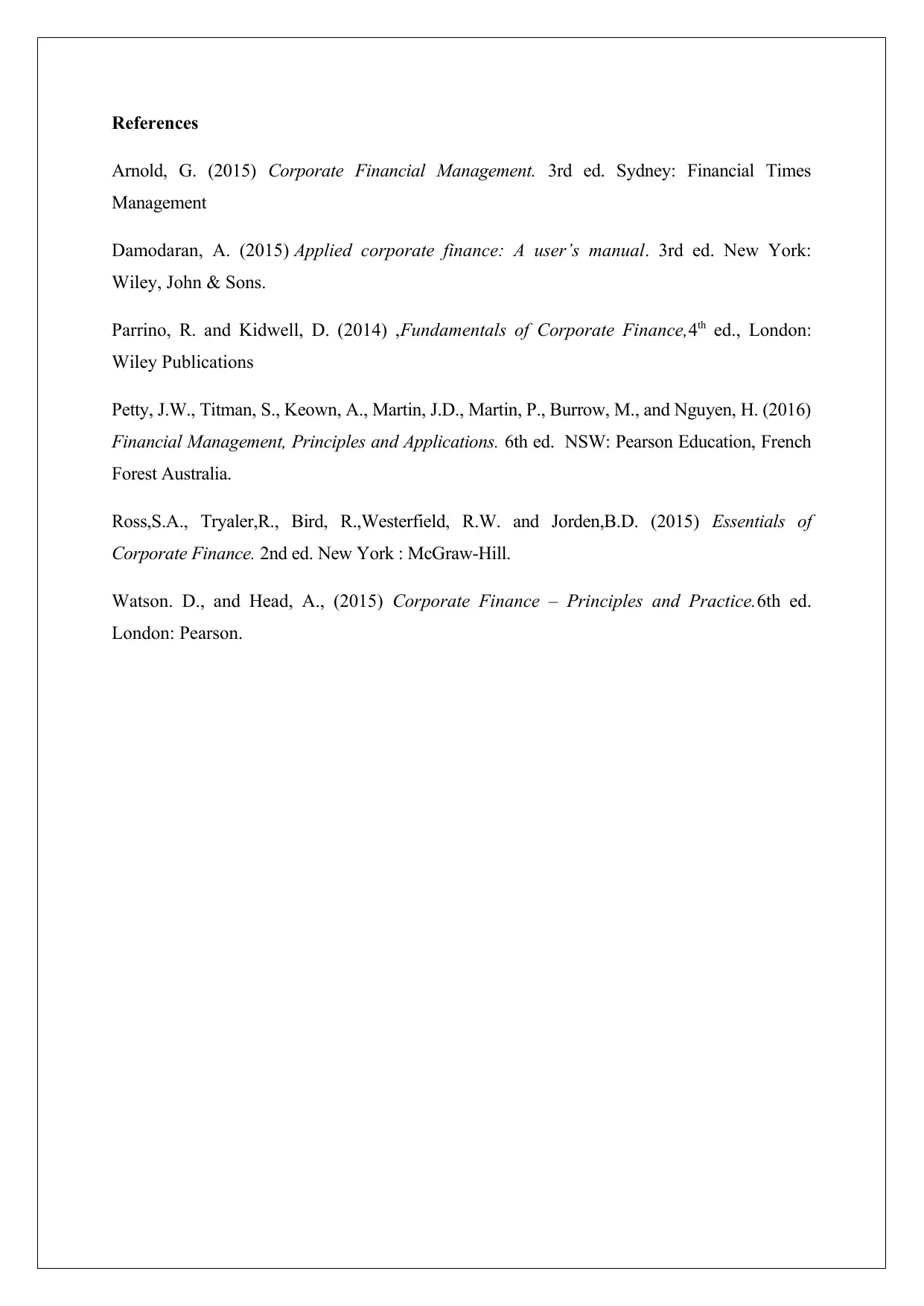Business Finance: Investment Strategy Report for Tri-Star Management
VerifiedAdded on 2022/10/09
|4
|987
|2
Report
AI Summary
This report, prepared for Tri-Star Management clients, offers a detailed analysis of the potential risks associated with selected stocks and provides investment recommendations based on their current pricing and anticipated future performance. The report compares the risk profiles of companies like NAB, WBC, ANZ, Qantas, and AGL Energy, utilizing beta values to assess systematic risk. It further determines whether stocks are over or underpriced by comparing required and actual returns using the Capital Asset Pricing Model (CAPM). The analysis concludes with recommendations to invest in an equal-weighted portfolio of ANZ Bank and Qantas, emphasizing diversification to mitigate overall risk and maximize potential returns. The report also includes references to relevant financial literature.

BUSINESS FINANCE
STUDENT ID:
[Pick the date]
STUDENT ID:
[Pick the date]
Paraphrase This Document
Need a fresh take? Get an instant paraphrase of this document with our AI Paraphraser

a) The objective of the given report is to offer advice to investors of Tri-Star Management in
relation to the potential risk associated with the selected stocks on which forecasts have
been presented. Additionally, the report aims to provide investment recommendations to
client on the basis of the current pricing of the selected company stocks considering their
likely future performance.
(i) Comparison of Risk
If an investor has a well diversified portfolio, then it is assumed that only systematic risk is
present and is traditionally captured using beta. This is a relative measure of risk which uses
market index as the base. Amongst the selected stocks, there are three companies from the
banking industry namely NAB (National Australia Bank), WBC (Westpac Banking
Corporation) & ANZ which tend to have similar beta values of 1.03, 1.22 and 1.17
respectively. These are big banks and the performance of the sector is essentially dependent
on the growth of Australian economy. As a result, the beta of these companies is close to 1
only. Further, going forward, the key faced by these two banks would be on account of any
slowdown in Australian economy along with crash in the housing market (Petty et. al., 2016).
Another selected company is Qantas which is the biggest airline based on Australia. The beta
for this company is 1.8 which reflects that the business is risky in comparison with banks and
market in general. This is true considering the extent of competition in the airline industry.
Also, the profitability of business operations is significantly influenced by the price of fuel
which tends to vary a lot owing to which the stock price fluctuates significantly. Going
forward, highly fuel prices may lead to erosion of profitability (Parrino and Kidwell, 2014).
Yet another company is AGL Energy which is into generation of power along with
distribution of electricity and gas. Considering the nature of the business, the risk is
comparatively lower which is also reflected in the beta of the company which is only 0.73.
The company is mainly subjected to regulatory risk on account of change in government
policy (Ross et. al., 2015).
(ii) Overpriced or Underpriced
In order to determine whether the stock is overpriced or underpriced, a comparison between
the required return and actual returns based on the forecast has been done. If the required
return of the stock exceeds the actual returns, then it would imply that the stock is overpriced
and it would have to become lower in price to ensure that expected returns are met (Watson
and Head, 2015). On the contrary, if the required return of the stock is less than the actual
relation to the potential risk associated with the selected stocks on which forecasts have
been presented. Additionally, the report aims to provide investment recommendations to
client on the basis of the current pricing of the selected company stocks considering their
likely future performance.
(i) Comparison of Risk
If an investor has a well diversified portfolio, then it is assumed that only systematic risk is
present and is traditionally captured using beta. This is a relative measure of risk which uses
market index as the base. Amongst the selected stocks, there are three companies from the
banking industry namely NAB (National Australia Bank), WBC (Westpac Banking
Corporation) & ANZ which tend to have similar beta values of 1.03, 1.22 and 1.17
respectively. These are big banks and the performance of the sector is essentially dependent
on the growth of Australian economy. As a result, the beta of these companies is close to 1
only. Further, going forward, the key faced by these two banks would be on account of any
slowdown in Australian economy along with crash in the housing market (Petty et. al., 2016).
Another selected company is Qantas which is the biggest airline based on Australia. The beta
for this company is 1.8 which reflects that the business is risky in comparison with banks and
market in general. This is true considering the extent of competition in the airline industry.
Also, the profitability of business operations is significantly influenced by the price of fuel
which tends to vary a lot owing to which the stock price fluctuates significantly. Going
forward, highly fuel prices may lead to erosion of profitability (Parrino and Kidwell, 2014).
Yet another company is AGL Energy which is into generation of power along with
distribution of electricity and gas. Considering the nature of the business, the risk is
comparatively lower which is also reflected in the beta of the company which is only 0.73.
The company is mainly subjected to regulatory risk on account of change in government
policy (Ross et. al., 2015).
(ii) Overpriced or Underpriced
In order to determine whether the stock is overpriced or underpriced, a comparison between
the required return and actual returns based on the forecast has been done. If the required
return of the stock exceeds the actual returns, then it would imply that the stock is overpriced
and it would have to become lower in price to ensure that expected returns are met (Watson
and Head, 2015). On the contrary, if the required return of the stock is less than the actual

returns, then it would imply that the stock is underpriced and it would have to become higher
to ensure that actual returns reduce to the expected returns (Parrino and Kidwell, 2014).
The expected returns have been computed based on the capital asset pricing model where
based on the beta, risk free rate along with expected market returns where ASX 200 is taken
as the market proxy. This is shown below.
The comparison of the expected returns with the actual returns is shown below.
The expected returns on only two stocks are higher than the required return, which are ANZ
Bank and Qantas. Hence, there are only two stocks which are underpriced while the other
three stocks are overpriced.
(iii) Recommendation
It is advisable that the investor should choose the two stocks which are underpriced as these
present the highest scope for potential However, rather than investing in individual stocks, it
would be advisable that an equal weighted portfolio constituting of ANZ Bank and Qantas
should be formed as it would lower the overall risk and bring about the benefits associated
with diversification.
b) It would not be recommended that the investment ought to be made in an equal weighted
portfolio of the given five companies. One of the key reasons is that there are three stocks
from the banking industry which does not lead to diversification of the portfolio and hence
does not provide the related benefits to the investor (Arnold, 2015). Additionally, some of
the stocks included tend to be overpriced owing to which they would be expected to
deliver negative returns in the near future. As a result, equal weighted portfolio
constituting of ANZ Bank and Qantas should be formed (Damodaran, 2015).
to ensure that actual returns reduce to the expected returns (Parrino and Kidwell, 2014).
The expected returns have been computed based on the capital asset pricing model where
based on the beta, risk free rate along with expected market returns where ASX 200 is taken
as the market proxy. This is shown below.
The comparison of the expected returns with the actual returns is shown below.
The expected returns on only two stocks are higher than the required return, which are ANZ
Bank and Qantas. Hence, there are only two stocks which are underpriced while the other
three stocks are overpriced.
(iii) Recommendation
It is advisable that the investor should choose the two stocks which are underpriced as these
present the highest scope for potential However, rather than investing in individual stocks, it
would be advisable that an equal weighted portfolio constituting of ANZ Bank and Qantas
should be formed as it would lower the overall risk and bring about the benefits associated
with diversification.
b) It would not be recommended that the investment ought to be made in an equal weighted
portfolio of the given five companies. One of the key reasons is that there are three stocks
from the banking industry which does not lead to diversification of the portfolio and hence
does not provide the related benefits to the investor (Arnold, 2015). Additionally, some of
the stocks included tend to be overpriced owing to which they would be expected to
deliver negative returns in the near future. As a result, equal weighted portfolio
constituting of ANZ Bank and Qantas should be formed (Damodaran, 2015).
⊘ This is a preview!⊘
Do you want full access?
Subscribe today to unlock all pages.

Trusted by 1+ million students worldwide

References
Arnold, G. (2015) Corporate Financial Management. 3rd ed. Sydney: Financial Times
Management
Damodaran, A. (2015) Applied corporate finance: A user’s manual. 3rd ed. New York:
Wiley, John & Sons.
Parrino, R. and Kidwell, D. (2014) ,Fundamentals of Corporate Finance,4th ed., London:
Wiley Publications
Petty, J.W., Titman, S., Keown, A., Martin, J.D., Martin, P., Burrow, M., and Nguyen, H. (2016)
Financial Management, Principles and Applications. 6th ed. NSW: Pearson Education, French
Forest Australia.
Ross,S.A., Tryaler,R., Bird, R.,Westerfield, R.W. and Jorden,B.D. (2015) Essentials of
Corporate Finance. 2nd ed. New York : McGraw-Hill.
Watson. D., and Head, A., (2015) Corporate Finance – Principles and Practice.6th ed.
London: Pearson.
Arnold, G. (2015) Corporate Financial Management. 3rd ed. Sydney: Financial Times
Management
Damodaran, A. (2015) Applied corporate finance: A user’s manual. 3rd ed. New York:
Wiley, John & Sons.
Parrino, R. and Kidwell, D. (2014) ,Fundamentals of Corporate Finance,4th ed., London:
Wiley Publications
Petty, J.W., Titman, S., Keown, A., Martin, J.D., Martin, P., Burrow, M., and Nguyen, H. (2016)
Financial Management, Principles and Applications. 6th ed. NSW: Pearson Education, French
Forest Australia.
Ross,S.A., Tryaler,R., Bird, R.,Westerfield, R.W. and Jorden,B.D. (2015) Essentials of
Corporate Finance. 2nd ed. New York : McGraw-Hill.
Watson. D., and Head, A., (2015) Corporate Finance – Principles and Practice.6th ed.
London: Pearson.
1 out of 4
Related Documents
Your All-in-One AI-Powered Toolkit for Academic Success.
+13062052269
info@desklib.com
Available 24*7 on WhatsApp / Email
![[object Object]](/_next/static/media/star-bottom.7253800d.svg)
Unlock your academic potential
Copyright © 2020–2025 A2Z Services. All Rights Reserved. Developed and managed by ZUCOL.




